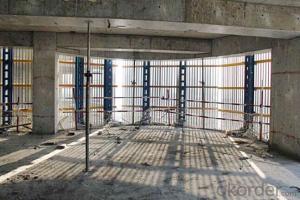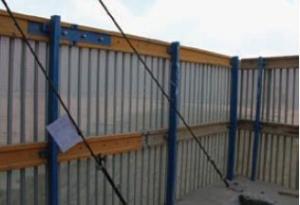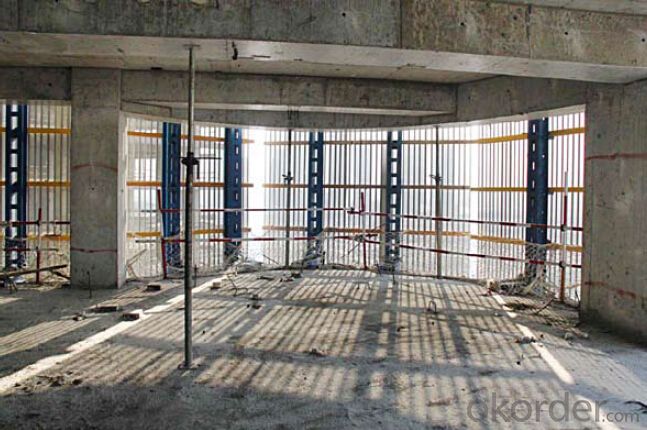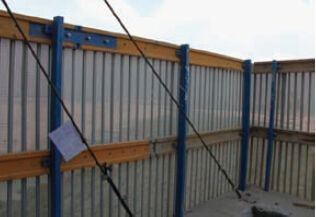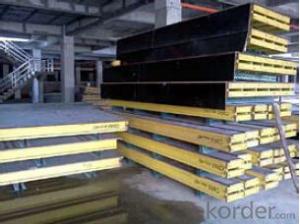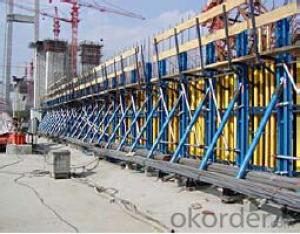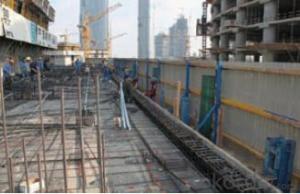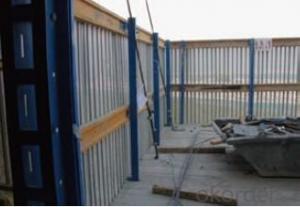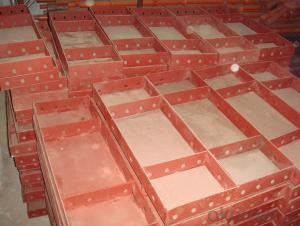Protection Platform for Formwork and Scaffolding Construction
- Loading Port:
- Tianjin
- Payment Terms:
- TT OR LC
- Min Order Qty:
- 50 m²
- Supply Capability:
- 1000 m²/month
OKorder Service Pledge
OKorder Financial Service
You Might Also Like
Protection Platform PP-50
A kind of new type construction protection system, applying operating platform and safer job
location for construction corps.
Characteristics:
◆ Easy and quick assembling.
◆ Lifted as a group, it is rapid and economic.
◆ Auto-climbing
◆ A safe and reliable anchor system
1. Composition
2. Assembly process of anchor system
(1) Embed V-climbing cone and anchor plate into the slab.
(2) Fix anchor shoe on the slab by tensile bolt.
(3) The fixed anchor shoe.
◆ High work efficiency with work platform and unload platform
◆ High light transmittance with the hollow block
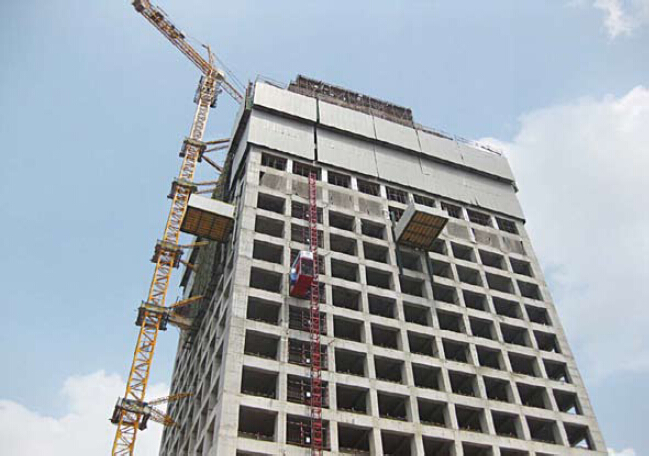
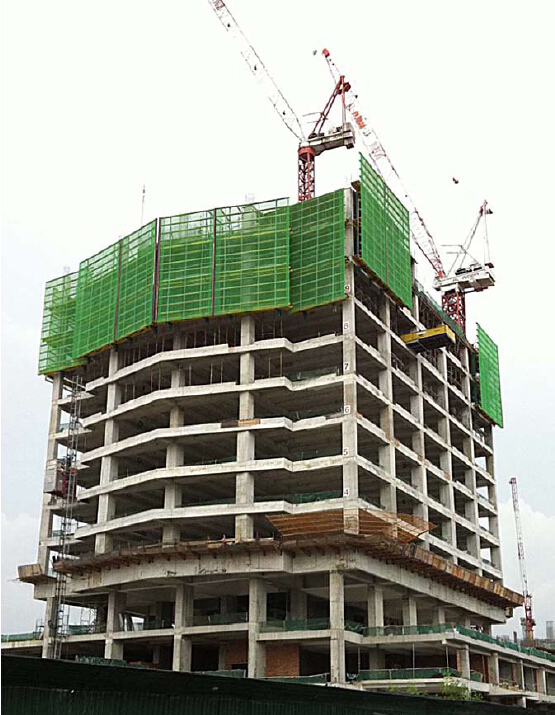
- Q: What are the common challenges faced during steel formwork installation?
- During steel formwork installation, one often encounters various common challenges. These challenges may differ depending on the specific project and site conditions. Here are some of the most prevalent challenges: 1. Precise alignment: Achieving accurate alignment of steel formwork panels can be difficult, particularly in large and intricate structures. It is crucial to ensure proper alignment for maintaining the stability and integrity of the formwork system. 2. Leveling and plumbing: Formwork must be level and plumb to ensure accurate concrete pouring as per the desired specifications. This task can be challenging, especially when working on uneven or sloping surfaces. 3. Formwork stability: To prevent movement or collapse during concrete pouring, steel formwork needs to be stable and securely anchored. Ensuring proper anchorage and stability can be challenging, particularly in areas with high wind loads or seismic activity. 4. Coordination of reinforcement placement: Installing steel formwork often involves coordinating with other trades, such as reinforcing steel installers. Challenges may arise in ensuring proper placement of reinforcement within the formwork, including sufficient clearance for concrete cover and appropriate spacing between bars. 5. Formwork removal: After the concrete has cured, the formwork needs to be removed without causing any damage to the concrete surface. This process can be challenging, especially when dealing with complex shapes or intricate details. 6. Reusability and maintenance: Steel formwork is designed to be reusable, but proper maintenance and care are necessary for its longevity. Challenges can arise in maintaining the formwork in good condition, especially when exposed to harsh weather conditions or rough handling. 7. Safety considerations: Steel formwork installation involves working at heights and handling heavy materials, which can pose safety risks. Challenges may include ensuring worker safety, implementing appropriate fall protection measures, and adhering to safety regulations and guidelines. In conclusion, steel formwork installation is a demanding and complex process that requires meticulous planning, coordination, and attention to detail. Overcoming these common challenges is vital for the successful completion of any construction project.
- Q: Can steel formwork be easily transported to different job sites?
- Yes, steel formwork can be easily transported to different job sites. Steel formwork is durable, lightweight, and can be disassembled and reassembled easily. It can be stacked and transported using trucks or trailers, making it a convenient option for construction projects in different locations.
- Q: What are the common design considerations for steel formwork in heritage buildings?
- When it comes to designing steel formwork for heritage buildings, there are several common considerations that need to be taken into account. These considerations aim to preserve the historical and architectural value of the building while ensuring efficient construction processes. Some of the key design considerations for steel formwork in heritage buildings include: 1. Historical Preservation: The primary goal in designing steel formwork for heritage buildings is to preserve and protect the historical elements of the structure. The design must respect the original architectural features, materials, and construction methods of the building while ensuring the formwork adequately supports the weight of the concrete during construction. 2. Structural Integrity: Steel formwork should be designed to provide sufficient support and stability to the structure during the concrete pouring and curing process. It is crucial to consider the load-bearing capacity of the formwork and ensure it can withstand the weight of the concrete, reinforcing bars, and construction equipment without causing any damage to the heritage building. 3. Flexibility and Reusability: Since heritage buildings often require restoration or repairs over time, it is essential to design the steel formwork in a way that allows for easy disassembly and reusability. This consideration ensures that the formwork can be removed without causing any damage to the building and can be reused for future construction projects. 4. Aesthetics: In heritage buildings, maintaining the original architectural aesthetics is of utmost importance. The design of steel formwork should consider the visual impact it will have on the structure. This may involve incorporating decorative elements or finishes that match the existing architectural style or using formwork that can be concealed or removed once the concrete is set. 5. Accessibility and Safety: The design of the steel formwork should take into account the safety requirements for the construction workers and the general public. It should ensure safe access to different areas of the building during construction and minimize any potential risks or hazards associated with formwork installation and removal. 6. Environmental Considerations: Sustainable design practices should be considered when designing steel formwork for heritage buildings. This may involve using recycled or low-impact materials, minimizing waste generation, and implementing energy-efficient construction techniques. In conclusion, the design considerations for steel formwork in heritage buildings revolve around historical preservation, structural integrity, flexibility, aesthetics, accessibility, safety, and environmental sustainability. By addressing these factors, architects and engineers can ensure that the construction process respects the heritage value of the building while meeting modern construction standards.
- Q: What are the typical load capacities of steel formwork systems?
- The typical load capacities of steel formwork systems vary depending on the specific design, size, and thickness of the steel components. However, they generally range from 50 kN/m² to 150 kN/m², allowing them to support heavy concrete loads during construction projects.
- Q: Can steel formwork be used for both standard and non-standard concrete sections?
- Steel formwork is suitable for both standard and non-standard concrete sections. It is a highly versatile option that can be customized to fit different shapes and sizes of concrete sections. Construction projects that involve unique or complex concrete structures often utilize steel formwork. It offers flexibility in creating non-standard shapes like curves, slopes, and irregular geometries. Moreover, steel formwork provides excellent strength and durability, making it perfect for both standard and non-standard concrete sections that require high load-bearing capacity. Its reusability also contributes to its cost-effectiveness, making it a viable choice for projects with varying concrete sections. In summary, steel formwork is the ideal solution for construction projects that require the flexibility and strength to accommodate both standard and non-standard concrete sections.
- Q: Can steel formwork be used for both small-scale and large-scale projects?
- Yes, steel formwork can be used for both small-scale and large-scale projects. Steel formwork is highly versatile and can be easily customized to suit different project sizes and requirements. It offers excellent strength and durability, making it suitable for large-scale projects that involve heavy concrete structures. Additionally, steel formwork can be re-used multiple times, making it cost-effective for both small and large projects. Its rigid structure ensures accurate and precise concrete placement, which is essential for achieving high-quality results in any project. Therefore, whether it is a small-scale residential construction or a large-scale commercial development, steel formwork is a reliable choice for the successful execution of concrete works.
- Q: What are the limitations of using steel formwork?
- Some limitations of using steel formwork include its high cost compared to other types of formwork materials, its heavy weight which makes it difficult to move and handle, and its susceptibility to corrosion if not properly maintained. Additionally, steel formwork requires skilled labor for its installation and removal, which can increase project costs.
- Q: What is the lifespan of steel formwork?
- The lifespan of steel formwork can vary depending on various factors such as the quality of the steel, maintenance practices, and frequency of use. However, with proper care and maintenance, steel formwork can last for many years, potentially even decades.
- Q: Can steel formwork be used for concrete stairs?
- Yes, steel formwork can be used for concrete stairs. Steel formwork provides a durable and strong structure that can support the weight of concrete and ensure the stability of the stairs during construction. It offers flexibility in terms of design and can be easily adjusted to accommodate different stair dimensions and configurations. Additionally, steel formwork allows for efficient and precise construction, resulting in high-quality concrete stairs.
- Q: How does steel formwork affect the overall fire resistance of a structure?
- Steel formwork does not directly affect the overall fire resistance of a structure as it is primarily used for temporary support during concrete pouring and construction. The fire resistance of a structure is generally determined by the materials used in its construction, such as the type of concrete, insulation, and fireproofing systems. However, steel formwork can indirectly contribute to the fire resistance by ensuring the proper placement and compaction of concrete, which is a key factor in achieving the desired fire resistance rating. The strength and durability of the concrete, when properly mixed and compacted, can enhance the overall fire resistance of the structure. Additionally, steel formwork can provide a smooth and uniform surface finish, which can facilitate the application of fireproofing materials. Fireproofing coatings or sprays are often used to enhance the fire resistance of structural elements, such as beams and columns. The smooth surface provided by steel formwork can help ensure an even and effective application of these fireproofing materials, further enhancing the fire resistance of the structure. It is important to note that while steel formwork itself is not fire resistant, it is typically removed once the concrete has cured, and the final fire resistance of the structure is determined by the materials used in its permanent construction.
Send your message to us
Protection Platform for Formwork and Scaffolding Construction
- Loading Port:
- Tianjin
- Payment Terms:
- TT OR LC
- Min Order Qty:
- 50 m²
- Supply Capability:
- 1000 m²/month
OKorder Service Pledge
OKorder Financial Service
Similar products
Hot products
Hot Searches
Related keywords
